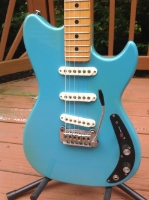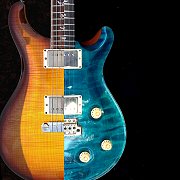Hey all, I'm new to G&L's and recently found a used climax in excellent shape except for a shifted neck, I actually got the owner to knock a hundred bucks off because of it. needless to say, after finding this site, while researching my new acquisition, I pulled the neck off to date it, and find out what neck it had, I found a nasty surprise.
WTH, someone re-drilled the holes, created an extra hole, and enlarged the holes on the top side of the neck pocket, all 3 screws go in at an angle.
So, my question is, should I drill and dowel as I've seen Dan Erlewine do, or should I epoxy them? I have a Hard Man machinable epoxy that bonds to wood, tht can be machined, and even tapped. I have used this same epoxy on the same repair on a Carvin neck in the past. I will also have to do it on the body as well.
Sorry for the poor quality, but you get how bad it is
https://goo.gl/photos/bWEQshRYfq9ogngd6
Nothing like a nasty surprise
-
grindliner
- Posts: 4
- Joined: Mon Nov 28, 2016 5:30 pm
- Location: Deeetroit!
-
KenC

- Posts: 2344
- Joined: Thu Feb 17, 2011 7:18 pm
- Location: None of the above
Re: Nothing like a nasty surprise
Welcome to G&LDP. I'd have to think about that repair a bit. My first thought is that either dowels or epoxy should work, but dowels in the body will give you more flexibility for seating the neck during a setup. Getting it in the right sequence to have the neck tight and square in the pocket, and the plate in the right place, will be the tricky part. Did the modder leave the micro-tilt screw alone? If it's still there and in its original position, that will give you something to align the neck plate on.
Ken
Ken
-
Tooslowhand
- Posts: 412
- Joined: Fri Oct 09, 2015 8:59 am
Re: Nothing like a nasty surprise
Not sure what the right answer is for filling the holes, though I would think dowels would do the trick. Every week or so I get an email from StewMac. Recently one had a video link that showed the procedure they used to install a new bolt on neck on a Fender guitar that got burned in a club fire. I think it would be helpful in your case. Sorry I no longer have the link but you should be able to find it on their You Tube feed.
-
guitar_ed

- Posts: 381
- Joined: Tue Feb 09, 2010 7:30 am
- Location: Baja, Oregon
Re: Nothing like a nasty surprise
Hi,
Some fool.... the microtilt is pretty good. I have several guitars with it.
I would dowel it. A competent luthier should be able to get the neck on properly, and then you will have a playable guitar.
Keep us up to date with pix.
edg
Some fool.... the microtilt is pretty good. I have several guitars with it.
I would dowel it. A competent luthier should be able to get the neck on properly, and then you will have a playable guitar.
Keep us up to date with pix.
edg
Piss off a politician, register to vote.
-
grindliner
- Posts: 4
- Joined: Mon Nov 28, 2016 5:30 pm
- Location: Deeetroit!
Re: Nothing like a nasty surprise
Micro tilt is fine, the hole in the plate for the neck screw may have been enlarged. For the holes in the body, I wont have to drill all the way through, I would possibly use a forstner bit and only have to go half way through, as the holes on the back side of the body have not been enlarged as far as I can tell, I'm not worried about doing this myself, as I've done it once before. Just wondering if epoxy would be better than doweling.......Probably going dowels this time.
Here's the stwemac video I saw of Erlewine doing it, pretty simple and straight forward. some great ideas, such as sizing the dowel, the punched hole in the tape, and even using super glue, so you dont have to wait a day for wood glue to dry. the only reason I like the epoxy idea, is even he says in the video that with the dowel, you're screwing into the endgrain, wich isn't as strong as the body wood.
[video]https://youtu.be/vgtgcIlFGrs?list=FLzG5olNWj8L1vxaS0J4agtA[/video]
Here's the stwemac video I saw of Erlewine doing it, pretty simple and straight forward. some great ideas, such as sizing the dowel, the punched hole in the tape, and even using super glue, so you dont have to wait a day for wood glue to dry. the only reason I like the epoxy idea, is even he says in the video that with the dowel, you're screwing into the endgrain, wich isn't as strong as the body wood.
[video]https://youtu.be/vgtgcIlFGrs?list=FLzG5olNWj8L1vxaS0J4agtA[/video]
-
auriemma

- Posts: 4
- Joined: Tue Nov 15, 2016 12:35 pm
- Location: South Eastern, PA
Re: Nothing like a nasty surprise
Is there a chance you could glue in steel threaded inserts and use machine screws instead of self tappers?
Just an idea.
Just an idea.
--- Joe ---
77 Bradley LPC | 07 PRS CE22 | 11 PRS MC58 Artist | 04 Ltd EC-1000FM ASB | 95 Fender Strat | 03 Epi LP 56 GT P90 | 04 Fender Tele | 10 Epi LP Special II
06 Ovation Elite-T | 12 Martin GPCPA4
77 Bradley LPC | 07 PRS CE22 | 11 PRS MC58 Artist | 04 Ltd EC-1000FM ASB | 95 Fender Strat | 03 Epi LP 56 GT P90 | 04 Fender Tele | 10 Epi LP Special II
06 Ovation Elite-T | 12 Martin GPCPA4
-
grindliner
- Posts: 4
- Joined: Mon Nov 28, 2016 5:30 pm
- Location: Deeetroit!
Re: Nothing like a nasty surprise
Actually, I have access to our fastener lab at work, I talked to the guy who runs it, and I am going to run several through our tensile tester and hopefully take video of it, I want use some easily available epoxies (e.g.; the depot, lowes, menards) that say they are tappable, and compatible with wood. I found a study online that was done in 1926 by the bureau of standards, testing the tensil strength of different woods screw holding ability.
So far I am considering a couple from jb weld, loctite, and gorilla. I am going to use a 1 inch block of maple, with the same diameter screws as what are on my guitar. I will drill all my holes the same diameter, and depth, then fill them with epoxy, cure, drill pilot holes to 90% of the screws core diameter and install the screws to the same depth.
All being said, I know it's a bit of geek overkill, but it sounds fun, and I have access to the equipment. Plus, I don't like screwing into end grain
So far I am considering a couple from jb weld, loctite, and gorilla. I am going to use a 1 inch block of maple, with the same diameter screws as what are on my guitar. I will drill all my holes the same diameter, and depth, then fill them with epoxy, cure, drill pilot holes to 90% of the screws core diameter and install the screws to the same depth.
All being said, I know it's a bit of geek overkill, but it sounds fun, and I have access to the equipment. Plus, I don't like screwing into end grain
-
KenC

- Posts: 2344
- Joined: Thu Feb 17, 2011 7:18 pm
- Location: None of the above
Re: Nothing like a nasty surprise
I had a reply time-out a few days ago, and never got around to re-writing it.
I would be much more concerned about alignment than tensile strength. If your Climax is like most older G&Ls, there is not a lot of wiggle room in the neck pocket. They were fitted very tightly. Since you said the body holes won't need to be re-drilled, I would focus on repairing the neck holes, get the neck aligned perfectly in the pocket, and then mark the dead center for each new neck hole. If you get those exactly right, there should be just enough tolerance in the body holes to REALLY pull the neck tight against the end grain in the pocket with string tension, per the factory setup procedure in the Gallery.
I don't disagree with the overall approach in the video, but I also wouldn't do it exactly that way myself. He went through the whole sizing discussion just to arrive at being able to use a standard diameter turned dowel you can buy at the big box home improvement stores. That choice of cheap, easily available dowels is also why end grain drilling is involved. I would use plug cutters on a drill press with a piece of seasoned maple. I bought my plug cutters at a specialty woodworking store ten years ago, but you can also find a good set somewhere online like Lee Valley Tools. Cut a 1/4" plug, drill an appropriately sized hole (considering that the plug cutter might not be exactly sized), and go from there. As long as you pay attention when you insert the plug, you'll have the same grain orientation as the neck. I'm not sure it would be that important on the scale we're talking, but it would be a nice touch.
I don't agree with his approach to determining the length of the dowel. Since glue is not compressible, any that ends up in the bottom of the hole will prevent full insertion and require more chisel work. I would just drill the holes very slightly deeper than the piece of wood the plugs come from. I would also stick with Titebond wood glue. It won't dry instantly like superglue, but it also won't take a full day to get to working strength for these purposes. It will give you a better joint. It is also very easy to clean off any excess with a paring chisel.
Ken
I would be much more concerned about alignment than tensile strength. If your Climax is like most older G&Ls, there is not a lot of wiggle room in the neck pocket. They were fitted very tightly. Since you said the body holes won't need to be re-drilled, I would focus on repairing the neck holes, get the neck aligned perfectly in the pocket, and then mark the dead center for each new neck hole. If you get those exactly right, there should be just enough tolerance in the body holes to REALLY pull the neck tight against the end grain in the pocket with string tension, per the factory setup procedure in the Gallery.
I don't disagree with the overall approach in the video, but I also wouldn't do it exactly that way myself. He went through the whole sizing discussion just to arrive at being able to use a standard diameter turned dowel you can buy at the big box home improvement stores. That choice of cheap, easily available dowels is also why end grain drilling is involved. I would use plug cutters on a drill press with a piece of seasoned maple. I bought my plug cutters at a specialty woodworking store ten years ago, but you can also find a good set somewhere online like Lee Valley Tools. Cut a 1/4" plug, drill an appropriately sized hole (considering that the plug cutter might not be exactly sized), and go from there. As long as you pay attention when you insert the plug, you'll have the same grain orientation as the neck. I'm not sure it would be that important on the scale we're talking, but it would be a nice touch.
I don't agree with his approach to determining the length of the dowel. Since glue is not compressible, any that ends up in the bottom of the hole will prevent full insertion and require more chisel work. I would just drill the holes very slightly deeper than the piece of wood the plugs come from. I would also stick with Titebond wood glue. It won't dry instantly like superglue, but it also won't take a full day to get to working strength for these purposes. It will give you a better joint. It is also very easy to clean off any excess with a paring chisel.
Ken
-
grindliner
- Posts: 4
- Joined: Mon Nov 28, 2016 5:30 pm
- Location: Deeetroit!
Re: Nothing like a nasty surprise
I'm not cool with the use of superglue for this, won't do it. He's running a business, so I get it, faster turnaround time.
I like the dowel sizing idea, I never thought of that, none of the dowels I just bought at the depot are perfectly round, and, it's all subjective to how much runout there is on the drill press.
there will always be a void in the drilled hole, unless you taper the bottom of your dowel's point to the same angle of the drill bit.
I like the dowel sizing idea, I never thought of that, none of the dowels I just bought at the depot are perfectly round, and, it's all subjective to how much runout there is on the drill press.
there will always be a void in the drilled hole, unless you taper the bottom of your dowel's point to the same angle of the drill bit.